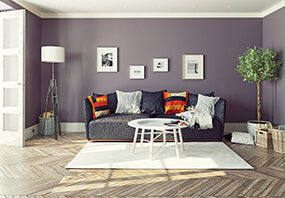Timber Flooring is ever popular for its beautiful look, easy maintenance, and classic style. There are many different types of timber to choose from – from traditional through to contemporary. Whatever style you choose, wooden flooring is a great way to breathe warmth and life back into your home.
Until recently hardwood floors were the only option in wooden flooring. The alternative was a fake wood look in materials such as laminate or vinyl flooring. Engineered floors are now ever popular. The floorboards come in multiple thicknesses and do not need to be glued down or nailed to a subfloor.
When you are deciding between a hardwood or an engineered timber floor there are many great styles and designs of flooring to choose from. There are a number of things to consider when choosing your flooring.
Hardwood Flooring
Hardwood flooring is made of solid wood. Common timber types are blackbutt, brush box, and bluegum. One of the major advantages are that they can be refinished and sanded many times over their lifespan.
The wood is always nailed down to a subfloor, which always required professional application and can take some time to do. The boards are designed to interlock when they are installed. Solid hardwood typically lasts 25 to 30 years but some types can last up to 100 years.
Solid hardwood floors are generally narrower floorboards than engineered flooring boards. There are generally more colours and types of wood to choose from if you are installing a hardwood floor than if you are installing a timber floor.
If your wooden floors are going to have a lot of wear and tear you may need to sand them back quite regularly to keep them well maintained. Hardwood floors are then a better option. Being naturally thicker, they can be sanded more times.
Hardwood flooring is a more expensive option than engineered. Hardwood timber flooring prices are more expensive than that of engineered prices. Our experts can provide you with an obligation free quote.
Hardwoods shrink and expand depending on the temperature and the humidity levels, and so are not recommended for basements or attics. Obviously, they cannot be used on floating floors.
Engineered Timber Flooring
Don’t get engineered floors mixed up with laminate. They are real timber.
Engineered timber floorboards are structurally stable as flooring materials and are less susceptible to shrinking and expanding than hardwood floors. They are, however, still prone to shrinkage and expansion due to changes in humidity. These must be accounted for when purchasing and installing the floors.
These floor types are incredibly simple to clean. They are easily wiped down with floor cleaner and the polish gives excellent results.
It is easy to repair an engineered floor. If it is a floating floor it is simple to remove and replace any planks if they become damaged.
By nature engineered floors have a thinner top layer than hardwood floors and so can only be sanded 3 times. Re-sanding is not generally done more than once every ten years though anyway, so an engineered floor can still have a very long lifecycle.
Engineered timber if not properly maintained is still subject to scratching even if scratch resistant finishes are used.
This flooring type is easy to install. Installing is much less expensive than installing a timber floor. Engineered flooring can sometimes be installed as a floating floor so there is no need to glue.
What’s not to love when it comes to quality timber floors? When choosing your floor type it really comes down to preference. The limitations of the install also make the biggest impact on which floor type will be right for your home or office. One floor type is not better than the other. Bamboo, vinyl, cork and parquetry and laminate are other options for you to consider.
For a quote on new flooring for your home or office, contact us. Our professional team at Stanton Flooring can provide a free quotation and advice.

